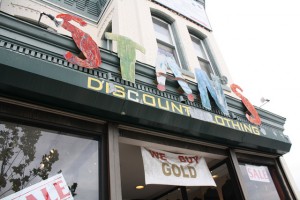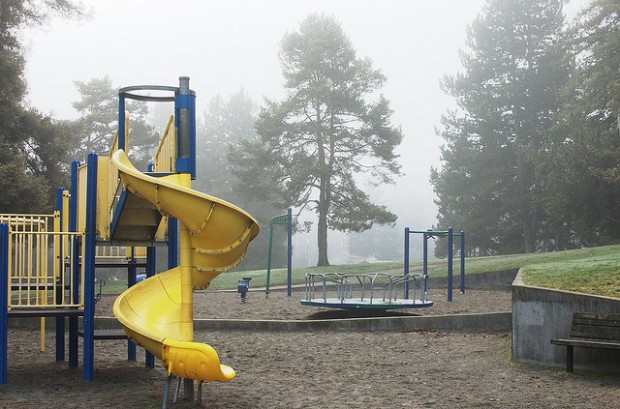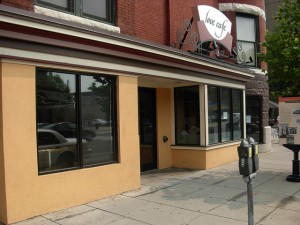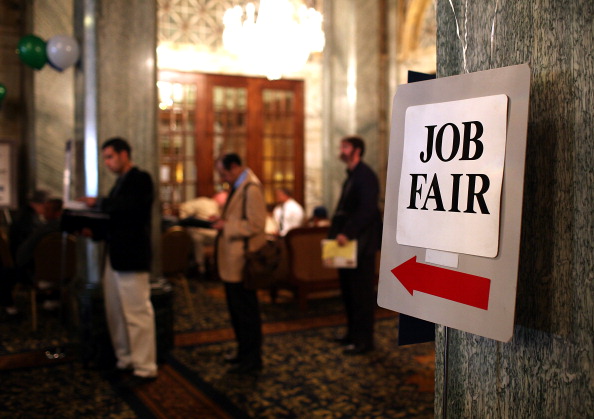It took years of organizing and lobbying — even a Stevie Wonder song — to get Martin Luther King, Jr. Day recognized as a federal holiday. People typically observe the day by volunteering as a way of paying homage to King’s legacy of service to humanity.
Or you could go to the club. King’s birthday and his image are being used to promote numerous parties around D.C. this year (Martin Luther King. Jr. Day is on Monday). The Washington Post’s Going Out Gurus have quite an exhaustive list of club fliers brandishing King’s words and face, and as they note, this isn’t the first year these images are being used to promote drink specials.
Just has D.C. as food deserts, it’s also home to “exercise deserts,” neighborhoods where it’s difficult to access recreational opportunities. Low-income communities may have plenty of parks and recreation centers, but it doesn’t mean people are able to take advantage of them.
A new Express series, “Standing Still’s Not A Choice,” explores D.C.’s physical activity disparities and how some people are overcoming them. The problem is about more than simply trimming waistlines — 15 percent of deaths in the District are related to obesity-related, Express reports.
Just 8.9 percent of white residents are obese, while 34.9 percent of black residents are. Those with less than a high school education are nearly three times as likely to be obese as college grads. The same goes for income level — 38.5 percent of people making $15,000 or less are obese, compared with 13.1 percent of those earning $75,000 or more.
Unfortunately, none of these statistics came as a surprise to the DOH’s then-director, Pierre Vigilance, who recognizes them as a reflection of nationwide problems. “Poverty affects not only your time, but it also may affect your energy level,” says Vigilance, now a visiting professor at the George Washington University School of Public Health and Health Services.
Read more at: www.expressnightout.com

Tom Bridge / Flickr
A view of Anacostia from west of the river.
On Monday, we wrote about how a nonprofit’s plans to open a transitional housing building in downtown Anacostia for homeless women has sparked protests by neighbors. Some feel Anacostia is becoming a “dumping ground” for social services, and this is hurting the neighborhood’s chances for economic development.
DCentric commenter Ann-Marie Watt, who is opposed to the project run by Calvary Women’s Services, had this to add:
A couple of years ago, I was volunteering and spoke with a homeless man in McPherson Square park. He said that he was an advocate for the homeless and operated a blog on homelessness issues. He was sooo angry at DC and other groups moving their services to Anacostia. He said that people were trying to get rid of the homeless population by moving them to the other side of the river. He also said that it would be more difficult to get back to the other side every day. So, what about that?…
Calvary is planning to relocate from Chinatown to Anacostia. It’s true that more job opportunities exist west of the Anacostia River than east of it. Traveling across the river can be timely or expensive; one alternative is the DC Circulator, which recently started running a rapid $1 bus line connecting Anacostia to the Potomac Avenue Metro across the river.
Continue reading →
Gentrification occurs when middle and upper-class people move into low-income communities, heralding renewed investment in these neighborhoods. It often results in some displacement of low-income people. Usually people think whites are the ones doing the gentrifying, particularly in D.C., but that’s not always the case.
An ongoing discussion is taking place on DCentric and our Los Angeles-based sister blog, Multi-American, which first wrote about “gentefication:” the process by which upwardly mobile and second-generation Latinos invest in low-income, Latino immigrant neighborhoods. We asked whether a more specific term should be use to describe what’s happening in some D.C. neighborhoods, where middle and upper-class African Americans are moving to and investing in low-income, black communities. Multi-American breaks down the discussion by reviewing readers’ comments.
For those concerned with housing costs in minority neighborhoods, the fear is that what are traditionally considered building blocks of gentrification – developers, high rents, wealthier white residents from outside the area – have a tendency to follow first-wave investors regardless of their ethnicity, with the next step being the area’s lower income residents pushed out as prices go up.
Readers of both blogs had quite a bit to say on the issue, good and bad.
Read more at: multiamerican.scpr.org

Elvert Barnes / Flickr
Stan's has been on H Street Northeast since 1978.
The H Street Northeast corridor has plenty of new bars and restaurants that draw evening crowds, but the area is low on daytime foot traffic. A new grant program is intended to change that by boosting the corridor’s retail options.
In the past, we’ve written about the $1.25 million grant program and about some fears that businesses catering to newer and wealthier clientele would benefit rather than longtime businesses. The grant was made available to new or existing businesses, as long as they weren’t restaurants, bars, liquor stores, hair salons or barbershops.
The first round of winners were announced Wednesday morning. They include Bikram Yoga Capitol Hill, H Street Care Pharmacy and Wellness Center and The C.A.T. Walk Boutique, all of which opened along the corridor between 2006 and 2010. That may lead to easy charges that the program is benefiting newer businesses over older ones. But also winning a grant: Stan’s Inc., a clothing store that has been in D.C. since 1947 and on H Street since 1978. DCist reports that owner Leon Robbins will renovate the store and expand its clothing line using the $85,000 award.
Continue reading →

Old Mister Crow / Flickr
Remember playtime, when you would use your imagination to create a world of your own, with little structure or guidance? That kind of activity, called “free play,” helps boost childhood development and leads to better behavior in schools. But a new report by the American Academy of Pediatrics found low-income children in cities have limited opportunities to play.
It would seem that free play would be quite accessible, given that you don’t need expensive lessons or toys to participate. But there are a number of socioeconomic factors preventing low-income children from playing. Here are three:
Continue reading →

tedeytan / Flickr
Anacostia's commercial corridor is filled with vacancies.
A vocal group of Anacostia residents have been rallying against a nonprofit’s plans to open transitory housing along the neighborhood’s business corridor. Calvary Women’s Services hopes to open along Good Hope Road, SE by summer, and provide semi-permanent housing for 50 formerly homeless women.
On the one hand, the objections can be viewed as typical NIMBYism. There’s also fear that placing transitory housing on an underutilized commercial corridor will cripple future economic development — while many of D.C.’s neighborhoods have undergone a transformation in which vacant buildings are converted into coffee shops and sit-down restaurants, Anacostia has lagged behind.
But the opposition in Anacostia is complex, which many residents say has become a dumping ground for social services because of the community’s demographics.
“There’s this perception about Anacostia that it’s all a bunch of poor black people who are out here struggling, and that they’d be happy to have [more social services] here,” said Nikki Peele, Congress Heights on the Rise blogger.
Continue reading →
Unemployment is down, but not for everyone, according to the U.S. Department of Labor. White and Latino unemployment rates dropped between 2010 and 2011, but unemployment among blacks in is the same as it was a year ago.
Latino unemployment is at its lowest since 2009, at 11 percent. White unemployment is 7.5 percent and black unemployment is 15.8 percent.

The black unemployment rate has been roughly double that of whites since the government started tracking the figures in 1972, Bill Rodgers, chief economist with the Heldrich Center for Workforce Development at Rutgers University, explained to CNN.
“Minorities and women are heavily concentrated in public sector jobs,” Rodgers explained to CNN. “With these major cuts we’re seeing in public employment, you’re going to see minorities pushed out of these jobs.”
Read more at: colorlines.com

Michael Feagans / Flickr
Love Cafe is closing on Jan. 29 after nine years on U Street.
Businesses move to transitional neighborhoods because space is cheap and there’s potential for future growth. But sometimes the economic success of these neighborhoods leads to the demise of the early gentrifiers.
Love Cafe opened at 15th and U Street, NW in 2003, two years before Busboys and Poets moved into the corridor and signaled rapid change in the community. This week, Love Cafe owner Warren Brown announced he’s closing Jan. 29 because rent has gotten too high. H Street Playhouse on H Street, NE is closing moving after it opened along the corridor in 2002, ahead of the trendy bars, restaurants and high rents.
Of course, some businesses that moved into neighborhoods at the beginning stages of gentrification do remain. They could be at an advantage because they got their feet in the door early. But gentrification happens in stages, and just like the longtime businesses that successfully weather gentrification, newer businesses also have to keep adapting to neighborhood changes in order to survive.

Justin Sullivan / Getty Images
Job seekers wait in line to enter the San Francisco Hire Event job fair on November 9, 2011. National unemployment was 8.6 percent in November.
The national unemployment rate dropped in December and 200,000 new jobs were added to payrolls, the U.S. Bureau of Labor Statistics announced Friday. Unemployment stands at 8.5 percent, down from 8.6 percent.
D.C.’s unemployment rate dropped slightly to 10.2 percent in November as the District saw the addition of 3,200 new jobs. Despite the good news, the District’s unemployment rate is still higher than the November 2010 rate of 10 percent. December unemployment figures for D.C. aren’t available yet.
A number of reasons are behind the District’s higher-than-national-average unemployment rate. Joblessness is much higher in wards of the city with high poverty rates and where fewer people have college degrees. The gap between skills and available jobs, as well as the difficulty of finding a job for those with criminal records, have made it difficult to combat unemployment in the District.










